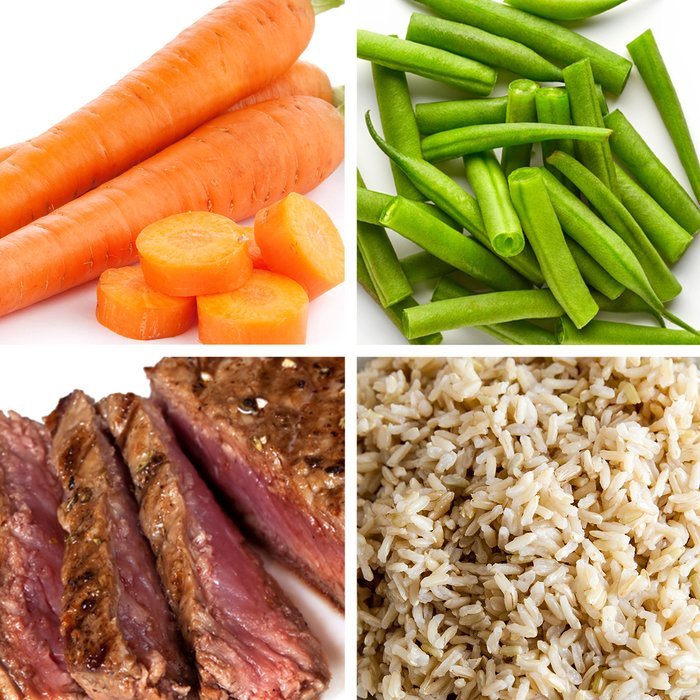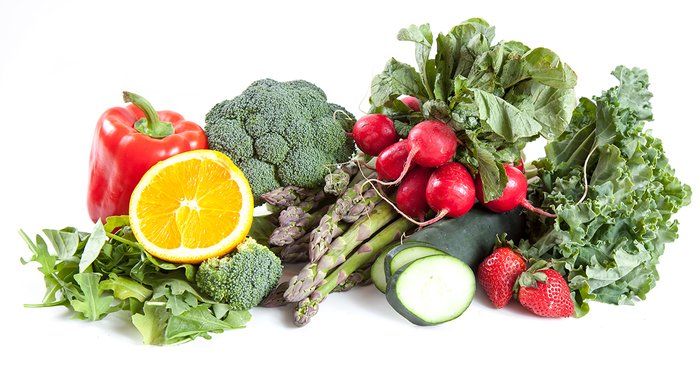The typical way to meal prep is to come up with a bunch of recipes, figure out how much of what ingredients you need to make each one, then head to the store. Just doing this—never mind the actual cooking—can kill an entire evening or afternoon. There's got to be a better way, right? Well, maybe there is. Casey Moulton, the Kitchen Karate guy, suggests basing your shopping list on a single number system instead of a bunch of recipes.
"Shopping by numbers is how the best chefs do it," Moulton says. "When you eat at craft food establishments, the executive chefs hand-pick the freshest ingredients at the best value each day. They make the menu after shopping, letting the ingredients inspire the dishes."
Meals are made up of three basic macronutrients: protein, carbohydrates, and fats. You can use a macro calculator to figure out how much of each you need every day. Basing your meals on macros, not recipes, is certainly a different approach, but it's how this professional chef shops for his own family of four.
"I can do all my shopping in 30 minutes, spend about $150, and end up with 15 home-cooked meals," he says. "I always buy fresh. I don't use delivery services because I like to see what looks the most appetizing and then pick exactly what I want. As I pick out each macronutrient, I'm starting to think about how I'll put them all together."
Select a Meal Template
The USDA's MyPlate drawing breaks down a dinner plate into how much of each macronutrient you need at each meal, but it's not the only template out there. You could also choose one of these:
- 4-Part Heart-Healthy Template: two-parts produce, one-part meat, one-part whole grains or beans
- 4-Part Vegetarian Template: two-parts produce, two-parts grains/beans
- 3-Part Grain-Free Template: two-parts veggies or fruit, one-part meat
- 3-Part Slow-Carb Template: one-part veggies, one-part meat, one-part beans

Of course, these aren't the only possibilities. If you're on a higher-protein or ketogenic diet, adjust your templates to meet your macronutrient needs. The idea is to choose just one template, then base all your meals on it. This approach makes meal prep simple. All you need to do is quickly calculate how many servings of each macro you'll need for each meal—instead of basing your shopping list on a handful of specific recipes.
For instance, if you're following a 3-part grain-free template, and you want to prep five meals for the week, you know immediately that you'll need five servings of meat and 10 servings of vegetables to prep accordingly. It's simple!
Understand Basic Serving Sizes
Of course, to shop this way, you need to know how to measure a "serving size." Moulton suggests using the hand approach to figure out how much of each macronutrient you need to purchase:
- 1 serving of vegetables = an open handful
- 1 serving of meat = a palm-sized piece
- 1 serving of grain or beans = a fist-sized amount
- 1 serving of oils and fats = a thumb-sized amount
The hand approach enables you to quickly eyeball whether a head of broccoli is two, three, or four servings, or if that package of chicken breasts contains 3 or 4 servings. When it comes to grains and beans, you can simply buy in bulk and portion out what you need, when you need it.
The only trick here is if you're shopping for multiple people. Keep in mind that you have to adjust portions up or down slightly based on the size and age of the people you're shopping for. After all, a child's hand is smaller than an adult's, so their serving sizes should be, too.
Create Your "Shop by Numbers" Tally Sheet
Now that you have an idea of how templates and portion sizes work, the rest is just simple math:
- Determine how many meals you're making for the week.
- Calculate how many portions of each type of food (veggies, meats, grains, beans) you'll need based on the number of meals you'll be preparing.
- Write your shopping list.

Let's say you want to prep 10 meals using the 4-Part Healthy-Heart Template (above). According to that template, each meal should consist of two portions of veggies, one portion of meat, and one portion of whole grains or beans.
That means you'll need 10 portions of meat, 20 portions of veggies, and 10 portions of whole grains or beans. Simple, right?
Shop Your Kitchen First
With your shopping list in hand, go through your fridge, freezer, and pantry and deduct from your list any servings you fill with food you already have. No sense in buying the same ingredients twice.
Using the tally system, you should be able to get your shopping done in about 30 minutes. Just head to the produce and meat departments and select the freshest ingredients at the best prices. Select what looks best until you've tallied up the total number of servings you need for your weekly prepping.
Buy Across the Rainbow of Foods
Moulton has one more tip: Don't buy all of the same foods week after week! Just because you need 20 portions of veggies doesn't mean you have to stick with the same old 10 portions of cauliflower and 10 portions of spinach week after week.

"Not only would that get super boring," Moulton says, "but it would deprive you of all the great nutrients you'd get from other vegetables."
Mix it up. Get all the servings you need, but do it by picking a couple of servings worth of each vegetable (maybe toss in a few more servings of your favorite ones). Spread the love around and get as many vibrant colors as you can into your diet.
It's Time to Prep
Once you're home with all your groceries, don't second-guess your decision to avoid using recipes. You've done a great job of buying exactly the right number of servings you'll need for each meal. Now, it's just a matter of putting all your macros together.
If you're new to prepping—or to cooking—Moulton suggests you think "a la carte," which is to say, "as if each individual serving of each macro were its own dish." All you have to do is select ingredients to fill each spot of your meal template, then decide how to prepare each one: Grill the chicken or broil it? Sauté the kale in olive oil or steam it with broccoli and top with sesame seeds? Boil some rice or bake a potato?
This open-ended approach to meal prep helps keep things from getting boring, and will expand your cooking skills, too. Mixing and matching different items based on your shop-by-numbers approach will keep your inner chef on his or her toes, your palate fresh, and your meals satisfying.

